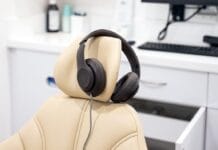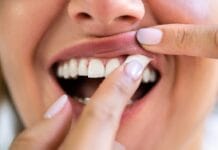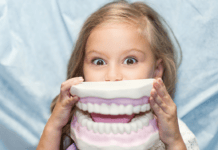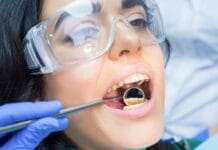Did you know that purple is the official color of dentistry? If you did, you probably have a purple T-shirt, headband, tumbler, or dental pin showing off your profession. If not, take a good look at your next dental hygiene event – there is definitely purple somewhere.
A family member recently asked me about the reasoning behind that color choice. Not knowing off the top of my head, I put on my research hat to find out.
If we want to get technical, lilac, a shade of purple, has been the designated color for dentistry since 1897, when the National Association of Dental Faculties chose it as the color for the emblem.1 The color is said to represent compassion, purpose, and inspiration.2 These traits definitely encompass the backbone of what makes up a dental hygienist.
If we dive a little deeper, we find the emblem or symbol of dentistry. This emblem may look familiar from pinning during graduation, or maybe it was on your white lab jacket in dental hygiene school.
The emblem of dentistry is taken from the Greek god of medicine and healing, Asclepius. Asclepius’ symbol is a snake wrapped around a physician’s staff, as the shedding of a snake’s skin represents healing and renewal. The ancient Greeks would use non-venomous snakes in healing rituals and let them crawl freely around the floor among the sick and injured in honor of Asclepius.3,4
Two Greek letters are also in the emblem: delta (triangle) and omicron (circle). Delta represents dentistry, and “odont” is represented by omicron. Remembering back to dental terminology, “odont” is of Greek origin and means tooth or having teeth of a specific nature.5,6
The part of the dentistry emblem that stands out to me is the detailed representation of 32 leaves and 20 berries. Any guesses? Is there any significance to those numbers, dental people? How about 32 permanent teeth in an adult dentition and 20 for the primary dentition?6
It was not until 1965 that the American Dental Association adopted the emblem as the official symbol of dentistry.6
Additional Interesting Dental Hygiene History
As I was looking into the history of the official color of dentistry, I stumbled upon other interesting histories. I found that the National Library of Medicine (NLM) holds a lot of historical dental content, including a 1939 photograph of a dental hygienist performing dental screenings on school-aged children in their classroom, 1940s dental cartoon postcards (an old-school meme), and a 1944 United States Navy dentistry tutorial.7
In addition, the NLM included the 1946 Indiana Dental Hygienist Law, a short pamphlet that details the beginning of certifying dental hygienists. Before these laws, certification was not required to practice dental hygiene in the state of Indiana.7 Eventually, certification laws were passed for each state, and by 1952, all 50 states required licensing for the practice of dental hygiene. To put things in perspective, the first state to pass dental hygiene laws requiring licensure was Connecticut in 1917, which involved Dr. Alfred Fones and the first licensed hygienist, Irene Newman.8
In 1935, the American Dental Hygienists’ Association and the American Dental Association recommended a high school diploma as a requirement for licensure. It wasn’t until 1940 that a two-year course of study was recommended prior to licensure.8
The minimum standard requirements for dental hygiene programs were adopted in 1947. In 1949, the American Dental Hygienists’ Association (ADHA) adopted the title “registered dental hygienist” as the official credential.8 A few years later, in 1952, the accreditation of dental hygiene programs is established.9 However, it was not until 1968 that the first regional board exam was given in the Northeast.8
In Closing
Dental hygiene has been around for over 100 years now. We should always look to improve and advance the profession, but we can also take a step back to appreciate how far we have come and acknowledge those who have helped us get there!
Before you leave, check out the Today’s RDH self-study CE courses. All courses are peer-reviewed and non-sponsored to focus solely on high-quality education. Click here now.
Listen to the Today’s RDH Dental Hygiene Podcast Below:
References
- National Association of Dental Faculties. Int Dent J (Phila). 1897; 18(9): 605-611. https://www.ncbi.nlm.nih.gov/pmc/articles/PMC10128655/
- San Francisco City Hall Lights Up in Purple in Honor of National Dental Hygiene Month. (2022, October 27). University of the Pacific. https://www.pacific.edu/pacific-newsroom/san-francisco-city-hall-lights-purple-honor-national-dental-hygiene-month
- Asclepius. (2024, June 7). Britannica. https://www.britannica.com/topic/Asclepius
- Wichmann, A. (2023, August 16). Snakes Were Used to Heal the Sick in Ancient Greece. Greek Reporter. https://greekreporter.com/2023/08/16/snakes-ancient-greece/
- Odont. (n.d.). Merriam-Webster. https://www.merriam-webster.com/dictionary/odont
- Worlinsky, C. (2014, March 19). A Closer Look at the Official Emblem of Dentistry. American Student Dental Association. https://www.asdablog.com/a-closer-look-at-the-official-dentistry-emblem/
- Franz, L. (2024, April 11). A Brush with the History of the Dental Hygienist. U.S. National Library of Medicine: Circulating Now. https://circulatingnow.nlm.nih.gov/2024/04/11/a-brush-with-the-history-of-the-dental-hygienist/
- 100 Years of Dental Hygiene Timeline. (2013). American Dental Hygienists’ Association.http://www.tiki-toki.com/timeline/entry/55646/100-Years-of-Dental-Hygiene/
- Accreditation Standards for Dental Hygiene Education Programs. (2025, January 31). Commission on Dental Accreditation. https://coda.ada.org/-/media/project/ada-organization/ada/coda/files/dental_hygiene_standards.pdf










